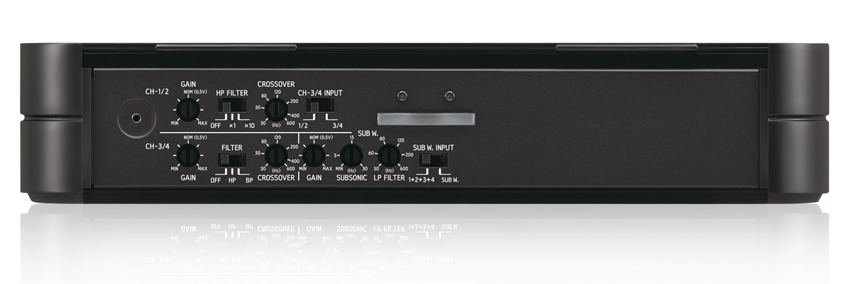Secrets of connecting and setting up car amplifiers
We independently test the products and technologies that we recommend.

You decided to improve the sound of the system in the car and bought an amplifier. Now we need to figure out how to properly connect it to the radio and acoustics, and then adjust it to achieve better sound quality. A number of actions must be performed before turning on the amplifier for the first time and then adjust it correctly.
Setting up before turning on for the first time
Before turning on the amplifier, it is important to pre-tune it. This can be done on an un-installed amplifier, knowing the composition of the components of the audio system:
1) the Gain or Level control should be at a minimum;
2) The LP filter for the subwoofer channel must be pre-switched on at 80 Hz, and the Sabsonic filter can be set to 20-30 Hz if a subwoofer is used in a phase inverter housing;
3) We pre-set the HP filter to the Full position for door speakers or in the back shelf, and if the amplifier is connected to small speakers 8-10 cm in the torpedo, then turn on the HPF at 120 Hz;
4) When using the amplifier in channel-by-channel mode, the HP filter for tweeters and LP for midbases must be pre-enabled at 4 kHz;
5) The HiLow Level switch must correspond to the type of connection. If a signal is coming to the amplifier from the acoustic wires, then you need to set the controller to the Hi Level position. If the signal is taken from the linear outputs of the radio, then we set the controller, respectively, to the Low Level position;
6) the bassbusters and equalizers must be turned off at the pre-adjustment stage;
7) on amplifiers equipped with an input selector, you can do without Y-splitters. For example, by switching the input selector to the 2CH position (copy the signal from the two RCA inputs to all other channels), you can connect a 5-channel amplifier to a tape recorder with only one pair of line outputs. But when using all linear RCA inputs, you must not forget to turn off the selector, otherwise the ability to adjust the sound from the radio will disappear.
The first inclusion
Turn on the amplifier and, first of all, look at the connection indicator — is it red or green. If you have connected everything correctly and no tendril from the wiring has closed, then the indicator will glow green, and if something is wrong - red. You can start the setup only in the first case. If the indicator is red, find an inaccuracy in the connection and fix it.
First, we adjust the input sensitivity (Gain or Level control). To do this, on a tape recorder with the equalizers and tone compensation turned off (LOUD), add the volume level until the clipped signal appears (noise, "wheezing", etc.). And then return the volume control a little "back" so that the audible distortions disappear. Leaving the sound at this volume level, we turn to the Gain or Level amplifier control and also find by ear the extremely loud undistorted sound of the front acoustics. We repeat the same procedure with the levels of the other channels and adjust them to the volume level of the front acoustics set at the beginning.
 |
| Amplifier panel with controls for sound adjustment |
Whether or not to use HPF for door speakers of 165 mm or ovals in the rear shelf, we determine by ear. According to theory, in audio systems with a subwoofer, it is necessary to unload the speakers from the low bass so that they reproduce the midrange frequencies more clearly and to limit the course of the diffuser. In fact, in some systems, low frequencies seem unnatural with HPF. It is possible that when the filter is turned off, the bass will become more dense, convincing, etc.
The use of a basbust among professional sound adjusters is considered not rational for both speakers and a subwoofer. Basbust increases, usually, the frequency of 40 Hz. Speakers with a much smaller diffuser stroke in comparison with a subwoofer stroke are not able to reproduce these frequencies loudly and cleanly, and a subwoofer playing only one note, to put it mildly, is not suitable for all styles of music. The subsonic filter is used for subwoofers with a phase-invert design. If in a closed volume the excessive stroke of the diffuser slows down the compressed air, then in cases with a pipe, only the subsonic will slow down the stroke of the diffuser. Usually this filter is set at a frequency slightly (a few Hz) below the phase inverter setting of the subwoofer used.
As you can see, the process of connecting and initial tuning of the amplifier is not as simple as with a conventional amplifier in a stereo system. However, if you follow these tips and instructions for the device, then you will succeed.
We find out what a battery is, what functions it performs and how to choose it for your car.
It is convenient to communicate with a Bluetooth headset not only while driving a car, but also in the office and on a walk.
Electric cars are on trend! And not only adults, but also children.
What you need to know to make an independent choice of a charger or a start-up charger.
We compare compact models for cleaning in the car and at home.












